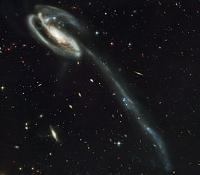11 Jun 2014
Satellite dwarf galaxies at the edges of the Milky Way and neighbouring Andromeda galaxies don’t fit the accepted model of galaxy formation, and recent attempts to pigeon-hole them into the model are flawed, an international team of scientists reports.
The mismatch raises questions about the accuracy of the widely accepted standard model for the origin and evolution of the Universe, the astrophysicists say. Their research paper, involving a Swinburne University of Technology researcher, is to be published in the Monthly Notices of the Royal Astronomical Society.
The standard model of galaxy formation says that satellite dwarf galaxies in the Milky Way and Andromeda are expected to behave in a particular way; the galaxies would form in halos of dark matter, be widely distributed and would move in random directions.
The 14 co-authors of the new paper – including Swinburne’s Professor Duncan Forbes – examined three recent papers by different international teams that concluded the planar distributions of galaxies fit the standard model. They found a substantial mismatch.
The researchers simulated mock observations of thousands of Milky Ways on a computer using the same data as the three previous papers.
“We observe the Milky Way satellite galaxies to be in a huge disk with almost all satellite galaxies moving in the same direction within this disk, like the planets in our solar system that move in a thin plane in one direction around the Sun. That’s unexpected for satellite galaxies and could be a real problem for the standard model of galaxy formation,” lead author of the study Dr Marcel Pawlowski, a postdoctoral researcher at Case Western Reserve University in Ohio, USA said.
In the Milky Way, the dwarf galaxies and accompanying star clusters lie in a huge plane the authors call the Vast Polar Structure. In Andromeda, half of the satellites are in the Great Plane of Andromeda.
The researchers found only one in a few thousand simulations matched what astronomers actually observe around the Milky Way.
“But we also have Andromeda,” Dr Pawlowski said. “The chance to have two galaxies with such huge disks of satellite galaxies is less than one in 100,000.”
“It seems that these disks of satellites should be very rare in the Universe, and yet the two galaxies that we know best, the Milky Way and Andromeda, both reveal huge satellite disks. This challenges our ideas of how satellite galaxies form,” Professor Forbes said.
The authors suggest an alternative to the standard model to explain the distribution of the satellite dwarf galaxies: an ancient collision between two large galaxies.
The collision may have ripped material from the large galaxies and thrown it a great distance, much like the tides on Earth. The resulting tidal dwarf galaxies are formed from this debris and arranged in a grand rotating disk. The researchers will continue to study these tidal dwarf galaxies and the clues they may reveal about galaxy formation.













